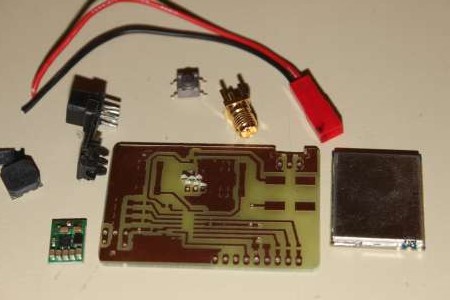Fatshark Base SD
Mai 2014
Related Pages
Ein paar Worte hab ich beim FPV Koffer schon dazu verloren.
Vielmehr möchte ich an dieser Stelle die Modifikationen vorstellen, die ich bezüglich der FS gemacht habe.
Da die Base SD ihr Bild nur über das beiliegende Kabel bekommen kann, wollte ich dennoch die Möglichkeit des kabellosen Empfangs haben.
Dazu galt es vorerst, die Pinbelegung des Futaba Steckers herauszufinden.
Die Skizze zeigt den Futaba Stecker von der innen, also Lötseite, wie er im linken Bild liegt.
Audio (Weiss), Audio (Rot), Video sowie Masse und VCC (bei der Fatshark am besten so 7V).
Den Futaba 6Pin Trainer Port Plug hab ich bei Hobbyking bekommen.
Masse und die Stromversorgung füren zu einem JST Stecker, an dem ein 2S Lipo angeschlossen wird.
Desweiteren führen alle Kabel zu einer Buchsenleiste, an welche ein Foxtech Receiver Modul gesteckt wird. Das Modul arbeitet mit 5V, wesshalb ein Stepdown (die kleine grüne Platine) davorgeschaltet ist.
Direkt an den Stecker hab ich eine Holzplatte mit etwas Klett darauf geklebt.
Das Receivermodul kann somit einfach abgenommen werden.
Der kleine LiPo (hier ein etwa 800mAh Exemplar) passt wunderbar in die Lasche am Kopfband.
Das Empfängermodul was ich damals verwendet habe, war sehr empfindlich gegenüber 2.4GHz. Sobald man die Fernsteuerung in die Hand nahm flimmerten die Streifen durch.
Da das ganze Teil selbst für meine Verhältnisse stark gefrickelt aussah hab ich dann nach langer Zeit einen zweiten Versuch gewagt, die Fatshark Base Mobil zu machen.
Auch hierfür hab ich wieder eines der günstigen 5.8GHz Empfängermodule genommen, aber diesmal wird es per SPI von einem ATTiny44 gesteuert. Also keine DIP Schalter mehr.
Die Platine wird nachher direkt an den Futaba Stecker geklebt und hält so an der Brille fest. Ein Pololu 5V Stepdown versorgt den ATTiny und das Modul. Die Spannung für die Brille wird direkt vom 2S Lipo durchgegeben. Auch dabei, ein Buzzer.
Um das Modul SPI sprechen zu lassen muss ein kleiner Widerstand (roter Pfeil) entfernt werden, wodurch SPI_EN offen gelassen wird und die Eingänge CH1,CH2 und CH3 zu SPI Pins werden.
Die Platine ist möglichst kompakt gehalten, sodass SPI Programmierpads nicht mehr passten. Also mussten zum Flashen ein paar Kabel direkt an den Chip gelötet werden.
Und dat wars. Nach einigen Stunden suchen hab ich dann auch einen dämlichen Fehler gefunden und es funktionierte.
Also, statt DIP’s zu schalten gibt es jetzt zwei Taster, mode und select. Mit dem Mode Taster schaltet man zwischen Band und Kanal auswahl um. Die LED’s auf der linken Seite zeigen das momentan gewählte Band oder Kanal als binäre Zahl, je nach dem was gerade gewählt ist. Bei der Frequenzbandauswahl werden nur zwei Bits benötigt (A,B,E und F Band), wodurch das MSB frei ist und im Bandwahl Modul blinkt. Zudem beim Band/Channel Wechsel und beim Einschalten piepst der Buzzer Band und/oder Kanal binär aus (kurz=0, lang=1). Durch kurz oder langes drücken des select Tasters kann Band oder Kanal eingegeben werden. Auch hier, binär: Lang lang kurz schaltet zu Kanal 6.
Werden beide Taster gleichzeitig gedrückt werden alle Kanäle durchlaufen und am Ende auf den geschaltet, der den höchsten RSSI hatte.
Auch ein Akkupiepser ist mit eingebaut, und fängt alle paar Sekunden an tief zu piepen wenn die Spannung unter ein eingestelltes Level fällt. Die Warnschwelle lässt sich einstellen, indem ein Akku mit exakt der einzustellenden Warnspannung angeschlossen wird, währen der Mode Taster gedrückt ist. Wenn der Buzzer die 16 bit binäre Ganzzahl vom adc ausgepiepst hat wurde die Spannung ins EEPROM geschrieben (sollte).
Hier natürlich noch der Schaltplan und das Board (PDF’s und Eagle Files), sowie der Sourcecode: mini5g8receiver_20160126.rar
So ganz so richtig gut funktionierte der Empfänger aber nicht. Sobald eine Fernsteuerung in einem 2m Umkreis an war machten Streifen und schlechter Empfang das Fliegen nicht unbedingt angenehm.
Vermutlich ist das Empfangsmodul schlecht, die Qualitätssicherung ist angeblich nicht sehr gut. Andere Fehlerquellen kann ich nach näherem Testen jedoch nicht ausschliessen.
Mit dem Bau des Tiny Whoop als Brushed Microquad für Indoorflüge musste eine funktionale Lösung der portablen Fatshark Base her.
Die RC305 Empfänger sind bei mir erfolgreich im Einsatz, wesshalb ich einfach einen getesten an die Brille bauen werde.
Einen “Futaba” Stecker für die Brille hatte ich noch übrig. Strom für Brille und Empfänger kommt von einem 3S, oder besser 2S LiPo/LiIon Akku, der am Ende eines etwas längeren Kabels hängt. Alles andere ist denke ich selbsterklärend.

















